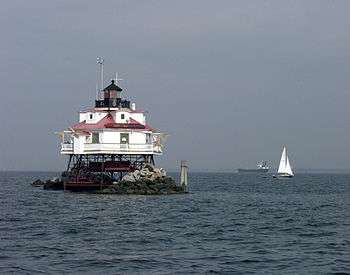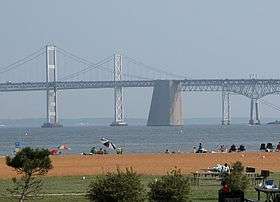Chesapeake Bay
The Chesapeake Bay is one of the world's largest estuaries, with waters extending through the states of Maryland and Virginia out to the Atlantic Ocean.

Cities
Main destinations
Delmarva Peninsula
- 🌍 Cape Charles
- Chesapeake City
- 🌍 Chestertown
- 🌍 Easton
- North East
- Onancock
- Oxford
- Rock Hall
- St. Michaels
Other destinations

Maryland
- Calvert Cliffs State Park
- Deal Island
- Elk Neck State Park
- Hart Miller Island State Park
- 🌍 Hooper's Island — one of Maryland's oldest inhabited places, a charming island known for sport fishing, crabbing, and the Hooper's Island Lighthouse
- Janes Island State Park
- North Point State Park
- Point Lookout
- Sandy Point State Park — one of the biggest beaches on the bay, right next to the Chesapeake Bay Bridge
- 🌍 Smith Island — a tight knit island Methodist community, who speak an isolated dialect reminiscent of Victorian-era England
- Tilghman Island
- Wye Island
Virginia
- First Landing State Park
- Kiptopeke State Park
- Tangier Island
Understand
History
The "Great Shellfish Bay," as it was known to Algonquins, is the largest estuary in the United States, at a full 200 miles long, and as wide as 30 miles. A good 10,000 years ago, this region was a valley lying along the Susquehanna River on its way to the Atlantic, but was flooded as the end of the last ice age led to rising oceans.
The Bay is one of the most naturally productive bodies of water in the world, in terms of aquatic life, because of its brackish salt-freshwater mix, and its shallow depth. The average depth of the bay is a mere 30 feet! These attributes combined to make the Bay an extraordinarily attractive for fishing, especially for shellfish like blue crabs, oysters, and mussels. Given the nature of the Bay, a famous Japanese fish farmer once boasted that, were the U.S. government to hand the Bay over to him, he could feed the entire world from farming just the Chesapeake alone.
Given its extraordinary productivity, the Bay has throughout its human history always been a major population center in the region. Before European settlers arrived, the shores were populated by Algonquian tribes, such as the Powhatan Confederation, Piscataway, and Nanticoke, as well as the Iroquoian Susquehannock in the north. Early British settlers gravitated towards the Bay for much the same reasons of easy fishing, and the communities surrounding the Bay such as Jamestown and St. Mary's City are some of the oldest European settlements in North America.
Today, however, the Great Shellfish Bay has been in a state of long-term decline for decades. Over fishing has been a problem, but may not have been possible if it were not for pollution. The Bay is plagued by agricultural and residential run-off of fertilizers into the Bay's tributaries, which causes enormous algae growth, which in turn chokes off the natural plant life of the bay upon which the fish rely for food. Environmental reforms have been enacted to protect the Bay (most strictly in Maryland, where the Save the Bay movement originated) but they differ state-to-state, and the tributaries of the Bay run through six states, making coordination difficult. This all has been a disaster for the fishing communities (especially the small island communities) around the Bay, who relied on hauls for almost their entire livelihood. Fishing is now tightly regulated, and the regulations have a good deal of support even from the fishermen, who realize that their way of life is threatened by the diminishing fish stocks.
Landscape

Flora & fauna
Get in
If traveling from far away, the best way to get in is probably BWI Airport. It is close to the major ports of Baltimore and Annapolis. BWI Airport is served by many major airlines and passenger rail service via Amtrak.
Route 50 is the most iconic Chesapeake Bay road, as it goes over the spectacularly large Chesapeake Bay Bridge (US Hwy 50/301), crossing from Central Maryland to the Eastern Shore; it also takes you right by Annapolis and Sandy Point State Park. On the east side of the bay, Route 301 is the main north-south road. On the northwest section above Baltimore it's Route 40, while Route 4 is the most useful road for Southern Maryland.
In Virginia, you can get around the southwest portion of the Bay on Route 360. The Chesapeake Bay Bridge-Tunnel is on US Route 13, and has a hefty toll of $12 each way, or $5 return within 24 hours (higher for trailers and large commercial vehicles). The bridge connects the Norfolk-Virginia Beach area with the Eastern Shore peninsula. If coming from the northeastern states, you can access the Eastern Shore by going south on US Route 13 through Delaware with no bridge crossing (Delaware I-95 South Exit 4A).
These are the only two bridges which cross Chesapeake Bay, and their web sites can easily be confused with each other for those unfamiliar with the region.
Get around
By boat

The best way to access the sights mentioned in this article is to use a boat. Getting access to a boat is sometimes a bit tricky, but here are some suggestions:
- Cruise ships offer Chesapeake Bay cruises from Baltimore. These week-long voyages visit many of the historic and charming ports on the Bay.
- Find a boat operator who will take you along. Many such operators exist in the major ports (Baltimore, Rock Hall, Annapolis, Crisfield, Norfolk) of the Chesapeake who will take you.
- Charter a boat. To do this, you need to prove to the owner of the boat that you are competent to operate it. Again, several charter providers exist in the major ports.
- Own a boat. If you own a boat, you are all set.
Some people prefer boats powered by the wind, others prefer those powered by motors.
By car
If you are using the aforementioned wheeled conveyance to visit these sights, there are a fine collection of roads, but only three crossing points in the 120 mile length of the bay. This makes some itineraries inconvenient.
See
- Wye River
- LaTrapp Creek on the Choptank River
- Little Choptank River
Itineraries
- One week sail from Annapolis
- One week sail from Crisfield
Do
Eat
- There are many small eateries on the shores of the Chesapeake Bay. Many serve the signature dish: Maryland Blue Crabs. You should definitely try some of them.
- The cities listed above have many good choices listed.
- With proper permit and patience, you can catch your own dinner!
Drink
Sleep